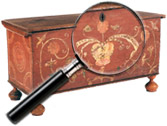|
|
Theresienstadt Nazi Prison Camp
Theresienstadt was established as a “proposed model ghetto,” to impress foreign visitors and the Red Cross. According to Campbell, Theresienstadt was nothing more than a transit point to the death camps in Poland. The denomination of these notes is meaningless, because a Krone, or Kronen, was not in use in either Germany or Czechoslovakia; therefore, the notes had value only within the confines of Theresienstadt.
Fairfax Family
Washington’s association with the Fairfax family was fortuitous. His half-brother, Lawrence, married Anne Fairfax, who was the daughter of Col. William Fairfax, cousin and agent of Thomas, Lord Fairfax. William’s son, George William, and George Washington became friends, and in 1748, a young Washington was allowed to accompany George William as part of a surveying party to the remote south branch of the Potomac. Washington had learned the rudiments of surveying in [...] Click here to continue reading.
Herschell-Spillman Company from North Tonawanda, New York. It was best known for their portable carousels. Horses from these machines were larger and more elaborate.
Charles Looff
Charles Looff was one of Coney Island’s original carousel artists. In 1870, at the age of 18, Charles Looff came to New York from Germany. He worked as a woodcarver in a Brooklyn furniture store. In the evenings he spent time carving wooden animals. Eventually, these were painted and erected at Coney Island — the famous seaside resort’s first carrousel. It opened in 1876 and was a great success.
Spillman Engineering Company of North Tonawanda, New York, produced portable carousels for carnivals and country fairs.
Marblehead Pottery
The Marblehead (Massachusetts) Pottery operated from 1904 to 1936 producing a small output of classically shaped ware in simple matte glazes, some with beautifully done handcarved designs. In 1912 a line of ten-enameled faience was introduced, including table ware, decorative pieces, bookends, etc.
Marblehead Pottery was founded by Herbert Hall as a handicraft program for the mentally ill. Arthur E. Baggs, noted Ohio potter, organized the technical work until 1915 when he [...] Click here to continue reading.
Masudaya Toy Robots
Toy makers have historically used interchangeable parts in their products, and occasionally updating an old form with an entirely new look to appeal to a different market or segment. To see how the Masudaya toy company followed this tradition with their robots, see p4A.com item numbers 18564, 18565, 18566 and 17565. These four robots share essentially the same body form but completely different “looks” and remain rare and highly collectible.
Cameo Pattern Depression Glass
One of the “star” patterns in Depression Glass, Cameo was manufactured by the Hocking Glass Co. of Lancaster, Ohio between 1930 and 1934. Sometimes called “Ballerina” or “Dancing Girl”, Cameo is the only Depression Glass pattern to include a human figure in its decoration as little dancing girls with long scarves appear in the plate borders surrounded by festoons and ribbon rows.
Pate de Verre Glass
“Pate de verre”, a French term for “paste of glass”, a form made from very early historical times by heating powdered glass or similar substances and hardened. Once formed in this manner, the object is carved, painted or has other decoration applied.
Issac Hewitt with six workers and three pottery wheels made stoneware at Rice’s Landing, Pennsylvania in the 1870′s. He termed his operation the “Excelsior Works” and stencil decorated his work with his and company name plus Rice’s Landing, Pa. (Price’s Landing Penna. and a Hewett spelling is also known). Hewitt is reported to have made 45,000 gallons of stoneware in the 1870′s, or about $6,500 worth in the currency of the day.
|
Recent Articles
- Charles Alfred Meurer – American Artist & Tromp L’Oeil Artist
- Sendak, Maurice – American Artist & Writer
- Godie, Lee – American Artist
- Davis, Vestie – American Artist
- Bartlett, Morton – American Artist
- Mackintosh, Dwight – American Artist
- Evans, Minnie Jones – African-American Artist
- Mumma, Ed (Mr. Eddy) – American Artist
- Nice, Don – American Artist
- Savitsky, John (Jack) – American Artist
- Gordon, Harold Theodore (Ted) – American Artist
- Dial, Thornton – African-American Artist
- Doyle Sam – American Artist
- Johnson, Lester Frederick – American Artist
- Finster, Howard – American Artist
|
|
